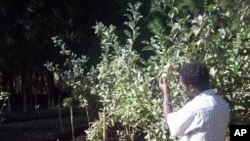The legendary American Johnny Appleseed secured his place in history for promoting the planting of apple trees throughout the young United States. Now, more than 200 years later, an environmental organization is doing much the same thing. However, the focus of Trees for the Future is on deforested regions around the world.
Ethan Budiansky, Head of International Programs at Trees for the Future, says trees can bring degraded lands back to life.
"They increase the amount of biomass. A lot of the trees being planted are nitrogen-fixing. They bring water tables back. They increase drinking water and irrigation water for the people that are planting the trees."
In Ethiopia, Washington-based Trees for the Future has distributed about 1.9 million trees. Program Coordinator for Ethiopia, Gabriel Buttram, says the program works with local communities to promote green agroforestry techniques that also help increase productivity.
He says by fixing nitrogen and using green fertilizers, such as leaves from the trees, planters can increase household food security. At the same time, Buttram says, growing trees can provide the locals with a source of income when they sell their mangos and papayas, or maringa leaves.
Deforestation is a serious environmental problem, often leading to soil erosion and degradation. Budiansky says one of the reasons for deforestation is what he calls "slash and burn" agriculture. The trees are cut down, the land is burned to clear it for crops. Once the corn, beans or perhaps peanuts have depleted the land of nutrients, the farmers leave, and cattle eat what little greenery still grows on the land.
“A recent FAO (Food and Agriculture Organization) report says we are losing somewhere around 13-million hectares of trees per year. That's about an area the size of (the U.S. state of) Rhode Island being cut daily."
One of the worst-hit areas of this disastrous practice is in Kenya, where Trees for the Future’s David Tye is the Regional Coordinator for East and Southern Africa.
"It has about two percent of the original forest cover left in Kenya. The other countries, Uganda and Tanzania, are not as bad, but still getting worse every year."
Tye says he encourages people to plant trees near their homes and farms, and the idea has taken root, especially in Kenya.
"People realize they need to plant trees. It's gotten so bad that women have to travel farther and farther for firewood. Adults talk about their childhood, how this forest used to be here but now it's gone. So people are really interested in planting trees now."
Trees for the Future has projects in 26 countries across the globe. Last year alone, the organization helped put more than 17 million trees in the ground.







